Part of Speech are classed into eight categories according to their uses in a sentence. Amazingly, only eight parts of speech are used to classify hundreds of thousands of words. The challenge is that many words can be used for more than one part of speech.
1) Noun
Name for a person, animal, thing, place, idea, activity.
Like → John, cat, box, desert, liberty, golf
2) Adjective
Modifies a noun or pronoun.
Like → big, good, full
3) Adverb
Modifies a verb, adverb, or adjective.
Like → quickly, loudly, here
4) Preposition
Precedes phrase that acts as a modifier or noun.
Like → with, for, at
5) Pronoun
Alternate name for a noun.
Like → he, she, it
6) Verb
Expresses action or existence.
Like → went, purred, is
7) Conjunction
Connects words, phrases, or clauses.
Like → and, or, but
8) Interjection
Expresses emotion.
Like → Gosh! Wow! Super!
How to Remember Part of Speech

What is Noun?
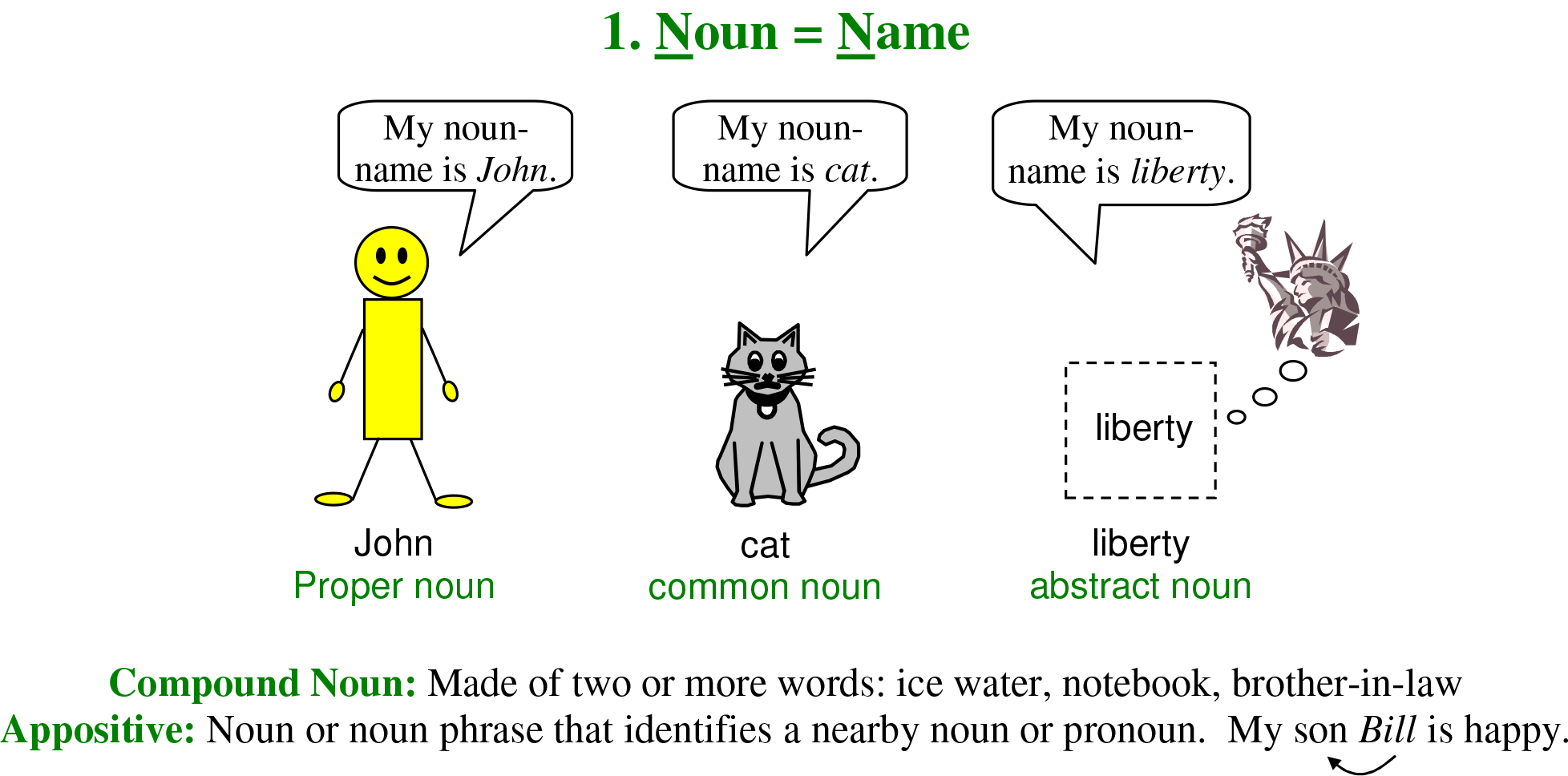
- A noun is a word or group of words that names a person, place, thing, or idea.The ability to identify nouns can help us avoid errors involving plurals, possessives, subject-verb agreement, and noun-pronoun agreement.
- There are two main types of nouns: proper nouns (which name particular people, places, things, and ideas and start with a capital letter) and common nouns. Nouns are far too numerous to list, but here are some Examples:
- PROPER NOUNS: Wednesday, Microsoft, English,Kincaid Street, Taj Mahal
- COMMON NOUNS: Student, friend, actor, supervisor, kitchen, enjoyment
How can we identify nouns?
- When you think of nouns as people, places, things, or ideas, some are easy to spot
Example:
- That silly dog just ate a whole banana peel.
- Martha still believes the moon is made of cheese.
- You can identify some nouns by knowing which suffixes (word endings) are typically designated for nouns:
Example:
- ance — clearance, allowance, dissonance
- ence — credence, impatience, difference
- er — dancer, writer, marauder
- ism — imperialism, industrialism, schism
- Remember that the part of speech a given word fits into depends on its context. Words that function like nouns but look like verbs may be particularly tricky to identify. Consider the following examples:
Example:
- Jae thinks walking is the best form of exercise.
- Gavin’s job is to entertain.
If you first identify the main verbs in each sentence (thinks and is), it is easier to see that walking and to entertain function as things or ideas.
- If you’re not sure whether or not a word is a noun, three noun tests can help. Nouns (with the exception of verb like nouns such as to entertain) have at least one of these traits with Examples:
- They can be plural: seven boxes, many canals, few women,
- They can be preceded by a, an,or the: a butte, a duplicate, an engineer
- They can become possessive (once the word is in possessive form, though, it functions as an adjective): Al’s horses, children’s habits, Europe’s economy, essay’s length
What is a Pronoun?

- A pronoun is a word (or two) that can take the place of a noun. If the pronoun is replacing a specific noun, that noun is referred to as the “antecedent” and usually appears earlier in the sentence. Without pronouns, some sentences would get really long and awkward because we would have to repeat the same nouns. Knowing how to identify pronouns can help us avoid errors of pronoun case, noun-pronoun agreement, and subject verb agreement.
- Pronouns are generally divided into eight categories: personal, possessive, reflexive, relative, interrogative, demonstrative, reciprocal, and indefinite.
Personal Pronouns:
I, you, he, she, it, we, they (used as sentence subject)
me, you, him, her, it, us, them (used as object of verb or preposition)
Example:
- I gave her the tickets.
- They seated us in the fifth row.
Possessive Pronouns:
my, your, his, her, its, our, their (used when followed by a noun)
mine, yours, his, hers, its, ours, theirs (used when not followed by a noun)
Example:
- My dog hasn’t been to your office since his last check-up.
- Is Stephen a friend of yours or theirs?
Reflexive Pronouns:
myself, yourself, himself, herself, itself, ourselves, yourselves, themselves
(used to add emphasis or refer back to the subject)
Example:
- I did it myself!
- Did your brother cut himself on the broken glass?
Relative Pronouns:
who, whom, whose, which, that (used when the antecedent appears earlier in the sentence)
Example:
- Meet the artist whose paintings hang in my living room.
- I live near the McKenzie River, which is too cold and turbulent to swim in
Interrogative Pronouns:
who, whom, whose, which, what (used for direct and indirect questions and have no antecedent)
Example:
- I wish I knew whom the judge likes best.
- What is making all that noise?
Demonstrative Pronouns:
this, these, that, those (used to specify a noun by preceding or replacing it)
Examples:
- This hat is adorable!
- I like these shoes much better than those.
Reciprocal Pronouns:
each other, one another (used to refer to individual parts of a plural antecedent)
Example:
- Students are encouraged to help each other with this assignment.
- I don’t know how Agnes and Elroy would survive without one another.
Indefinite Pronouns:
each, every, everybody, everyone, anybody, anyone, somebody, someone, nobody, no one, something (always singular) both, many, few (always plural) none, all, any, some, either, neither (plural or singular, depending on the context)
Example:
- Neither graduate student wants to do all the grading by herself.
- Some people try to make everyone happy; none actually succeed.
What is an Adjective?

- An adjective is a word that describes a noun (person, place, thing, or idea). Adjectives help us communicate our ideas more precisely and artistically. By knowing how to identify adjectives, we can avoid problems such as sentence fragments, excessive wordiness, and adjective/adverb mix-ups.
- Adjectives are far too numerous to name, but here are some examples: blue, cold, ancient, frustrating, dark, stormy, delighted, afraid, hairy, stressful, bold, normal, metallic, belated, enormous, special, sober, morose, tall, likeable, flat, noisy
How can we identify Adjectives?
- Adjectives often appear immediately before the noun they modify.
- The large grey dog won the competition.
- The verdant trees are swaying in the gentle breeze.
- Adjectives may also appear later in the sentence, particularly after a linking verb (such as be, become, seem, appear, look, and feel).
- I can’t believe my brother seems so arrogant!
- The shoes I bought are gorgeous but impractical.
- Certain suffixes (word endings) also indicate that a word may be an adjective:
- able—loveable, detestable, comfortable, portable, delectable
- al—royal, special, dental, legal, dual
- ant—expectant, extant, pleasant, relevant, pursuant
- ent—decadent, excellent, intelligent, belligerent, reverent
- Adjectives are sometimes created from verbs, so also look for –ed and –ing endings:
- The fairgrounds look deserted. (People deserted the fairgrounds.)
- The painted chair belongs here. (Someone painted the chair.)
- To determine whether or not a word can be an adjective, try one of the two following tests:
If the word makes sense after extremely, it can be an adjective extremely interesting, extremely delighted If the word makes sense when it appears between an article (a, an, and the) and a noun, it can be an adjective.
a delicious sandwich, an arid environment, the alleged kidnapper
What is a Verb?
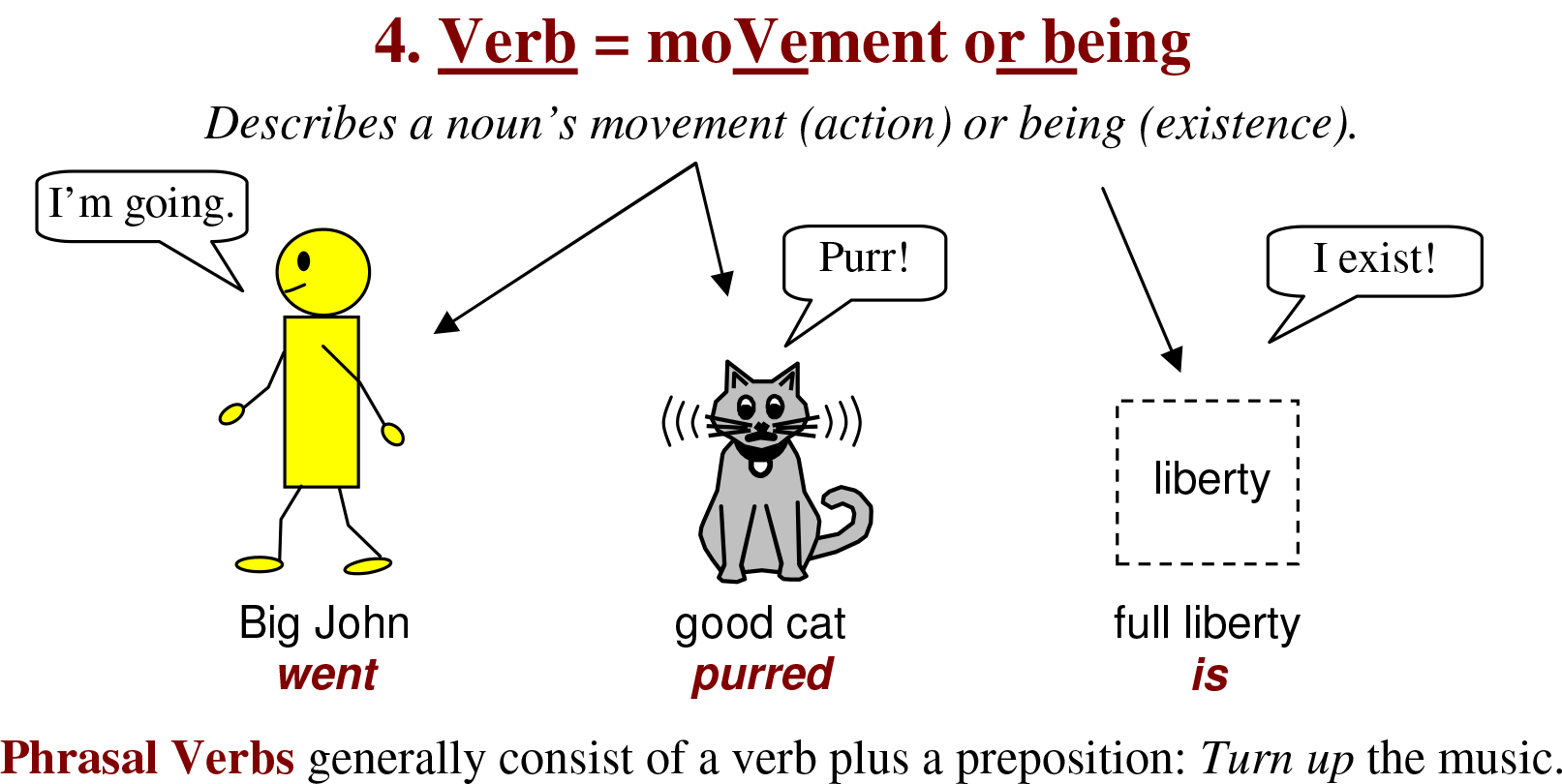
- A verb is a word or group of words that expresses action or state of being. Verbs are so important that a sentence cannot be complete without at least one.Knowing how to recognize them can help us avoid common grammatical problems such as run-on sentences, sentence fragments, and subject-verb agreement errors.
- Verbs are far too numerous to list, but here are some examples: see, chase, limp, soothe, injure, write, study, learn, teach, work, pursue, dive, swim, join, go, create, laugh, juggle, eat, drink, move, grow, earn, say, think, believe, need, enjoy, do, have, be, seem, have, can, should, may, will, want, become[/su_list]
How can we identify Verbs?
If you already think of verbs as action words, some are fairly easy to spot:
Example:
Jeannine throws the frisbee.
Albert jumps.
In other cases, the word that seems most like an action isn’t acting as a verb at all. In the following example, “skiing” is the thing Jin likes to do (a noun), and “is” expresses the state of being (the verb) of that thing.
Example:
Skiing is Jin’s favorite hobby.
As sentences become more complex and less action-packed, finding verbs may be even more challenging:
Example:
The professor thinks we should form a study group before we take the exam.
If you’re not sure which part of the sentence is the verb, these tests usually help
1.Change the time of the sentence. The word whose form changes to show the time difference is the verb.
For example, the sentences involving Jeannine, Albert, Jin, and the professor take place now (present tense). What if they took place yesterday, last week, or last year (past tense)?
Example:
Jeannine threw the frisbee.
Albert jumped.
Skiing was Jin’s favorite hobby.
The professor thought we should have formed a study group before we took the exam.
What if the sentences express ideas that will take place later this afternoon, next month, or ten years from now (future tense)?
Example:
Jeannine will throw the frisbee.
Albert will jump.
Skiing will be Jin’s favorite hobby.
The professor will think we should form a study group before we take the exam.*
*Note that, unlike the past tense, the future tense is not a good test for the latter two verbs.
2. Change the number of things the sentence is mainly about (the subject) from singular to plural or visa versa. The word in the sentence that changes form to accommodate this difference is the verb.
Example:
Jeannine and Samantha throw the frisbee.
Albert and his cat jump.
Skiing and snowshoeing are Jin’s favorite hobbies.
The professors think he should form a study group before he takes the exam.*
*Note that “should,” like many helping verbs, is unaffected by this change.
What is an Adverb?
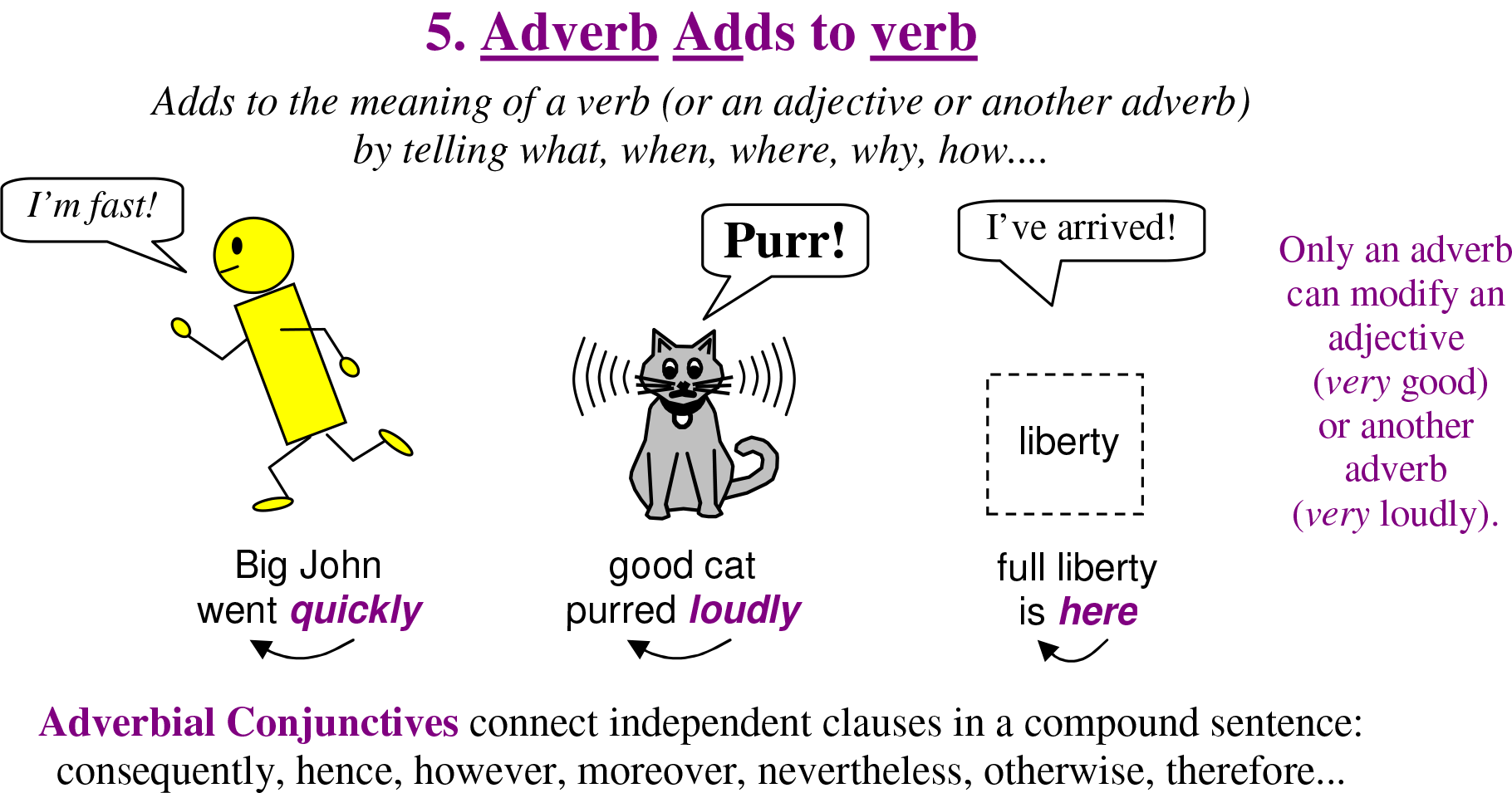
- An adverb is a word or phrase that modifies (describes) a verb, an adjective, another adverb, or even a whole sentence. Adverbs provide information about the how, where, when, and how much of an idea. Understanding adverbs can help us avoid modifier placement errors and adjective/adverb mix-ups.
The following are examples of adverbs’ various roles as modifiers:
- verb modifier → speak clearly
- adjective modifier → very bright
- adverb modifier → too slowly
- sentence modifier → Unfortunately, we haven’t had time to process your request.
Here are some examples of the type of information adverbs provide:
- how → passively, jauntily, peacefully, regretfully, ethically, capably
- where → here, there, where, far, near, wherever, anywhere, yonder
- when → yesterday, today, tomorrow, late, early, afterward, now, soon
- how much → too, very, so, extremely, totally, frequently, partially, fully, somewhat
How Can We Identify Adverbs?
As the examples above show, many adverbs end in –ly, so look for this ending as a clue. In particular, adverbs that show the “how” of an idea are formed by adding –ly to an adjective.
- possible →possibly
- careful → carefully
- happy → happily
- subtle → subtly
- Note: that there are exceptions to this pattern. Some –ly words, such as friendly and kindly, are adjectives, and other words, such as hard, wrong, low, and fast, take the same form as both adverbs and adjectives. Even slow and quick, which are primarily adjective forms, are commonly accepted as adverbs too. When in doubt, check a dictionary or usage guide.
- Transition words (sometimes referred to as adverbial conjunctions) form another major category of adverbs. These include words such as however, therefore, consequently, otherwise, moreover, furthermore, likewise, finally, also, and again.
- Adverbs that modify adjectives and adverbs appear immediately before those words; otherwise, adverb position is fairly flexible. If one word in a sentence may be moved around without changing the meaning of the sentence, it is likely an adverb.
- However, some examples may make this point clearer.
- Some examples, however, may make this point clearer.
- Some examples may make this point clearer, however.
- Frantically, Delaney waved her arms at the bus driver.
- Delaney frantically waved her arms at the bus driver.
- Delaney waved her arms frantically at the bus driver.
What is a Conjunction?

- A conjunction joins two or more parts of a sentence. Conjunctions provide the glue that helps us create varied and complex sentence structures. By understanding them, we can more easily avoid run-on sentences, fragments, and comma errors. Conjunctions are given below
- Coordinating conjunctions are sometimes referred to as the “fanboys” as a way to remember the first letter of each word in this category: for, and, nor, but, or, yet, so
- Subordinating conjunctions are numerous, but here are some of the most common ones: after, although, because, before, even if, even though, if, if only, in order that, now that, once, since, so that, though, unless, until, when, whenever, where, whereas, while
- Correlative (item pairs): both-and, either-or, neither-nor
What is a Preposition?
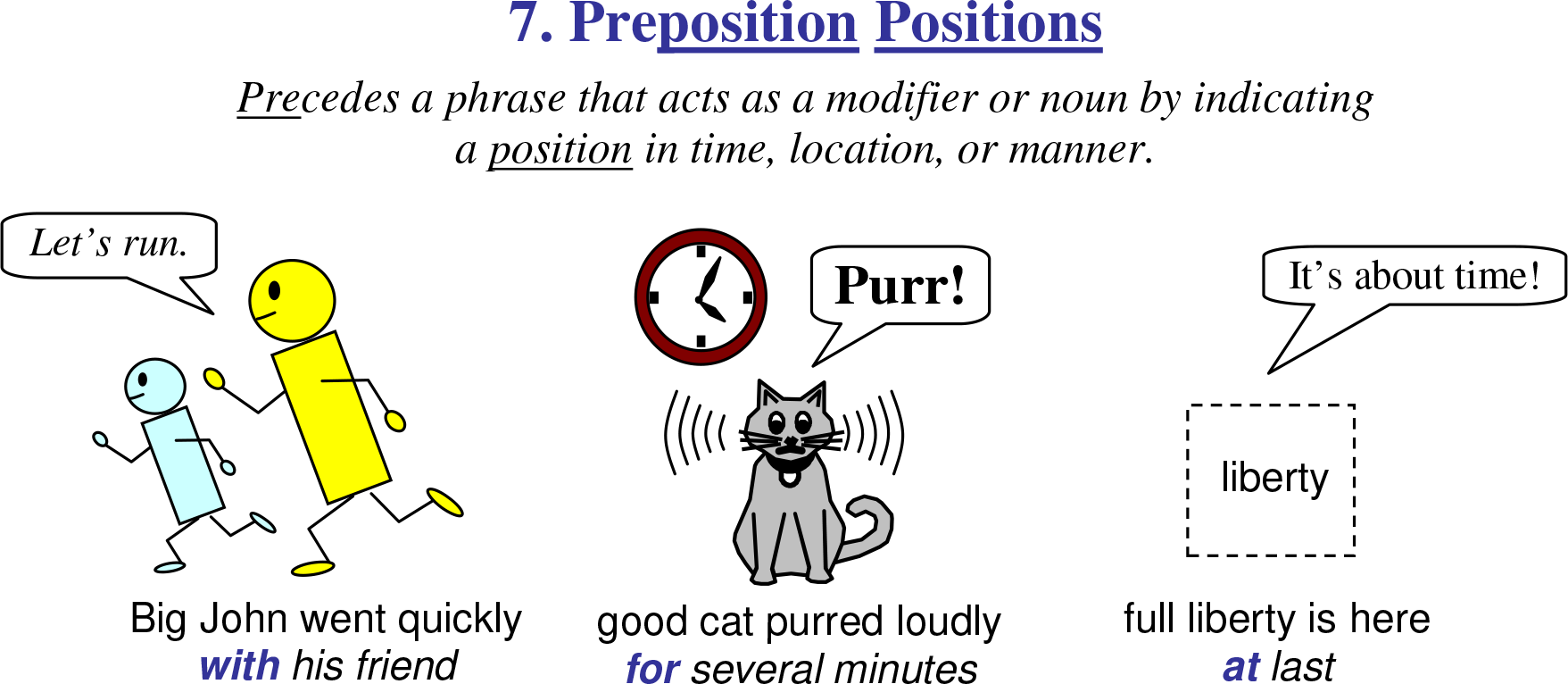
- A preposition is a word (or words) that creates a relationship between a noun or pronoun and another part of the sentence. Many prepositions express relationships in time and space. Knowing how to recognize them can help us avoid errors involving subject verb agreement and pronoun case.
- There are many prepositions in English, but the following list includes some of the most common ones: about, above, according to, after, against, along with, among, around, at, before, behind, below, beside, between, beyond, by, concerning, despite, due to, during, except, for, from, in, in between, in spite of, into, near, of, off, on, on account of, onto, outside of, over, past, since, through, to, toward, under, until, up, with, without
How Can We Identify Prepositions?
Familiarize yourself with the above list. Some people remember space-related prepositions by thinking about what a squirrel can do to a tree. Here are just a few examples:
- A squirrel can go → around a tree, behind a tree. , in a tree. , toward a tree., up a tree.
In the squirrel examples, the preposition shows the relationship between the squirrel and the tree. Tree (or whatever noun or pronoun follows the preposition) is called the “object of the preposition.” The object may consist of only one word, or it may be quite long:
Example:
- Will you come with me?
- Will you come with me, my twenty-seven loud, ill-mannered, short-tempered five-year-old cousins, and the world’s largest traveling parakeet collection?
“Prepositional phrase” is the term for a preposition and its object. Prepositional phrases may appear back to back, so the number of prepositions in a sentence is limited only by the patience of the reader and writer.
Example:
I will stay with the best friend of my sister at the cabin near the river in the valley between the two most beautiful mountains in Wyoming until February despite the weather.
In some situations, it is difficult to tell whether a word is functioning as a preposition or as part of a verb. Try these tests for the word in question
- Can you replace both it and the verb with another verb? If not, the word is a preposition.
Example:
- I think I might pass out.
- I think I might faint. (out ≠ preposition)
- I passed by my old locker.
- I walked by my old locker. (by = preposition)
- Can you put an adverb between the verb and the word in question? If so, the word is a preposition.
Example:
- Turn quickly in your homework. (in ≠ preposition)
- Turn quickly in a circle. (in = preposition)
- Can you put a noun immediately in front of the word (in addition to after it)? If not, the word is a preposition.
Example:
- I’m looking up the figures.
- I’m looking the figures up. (up ≠ preposition)
- I’m looking at the giraffe.
- I’m looking the giraffe at. (at = preposition)
- If the word is to, is it followed by a verb (instead of a noun or pronoun)? If not, the word is a preposition.
Example:
- Josie drove to relax. (to ≠ preposition)
- Josie drove to the mall. (to = preposition
What is Interjection?
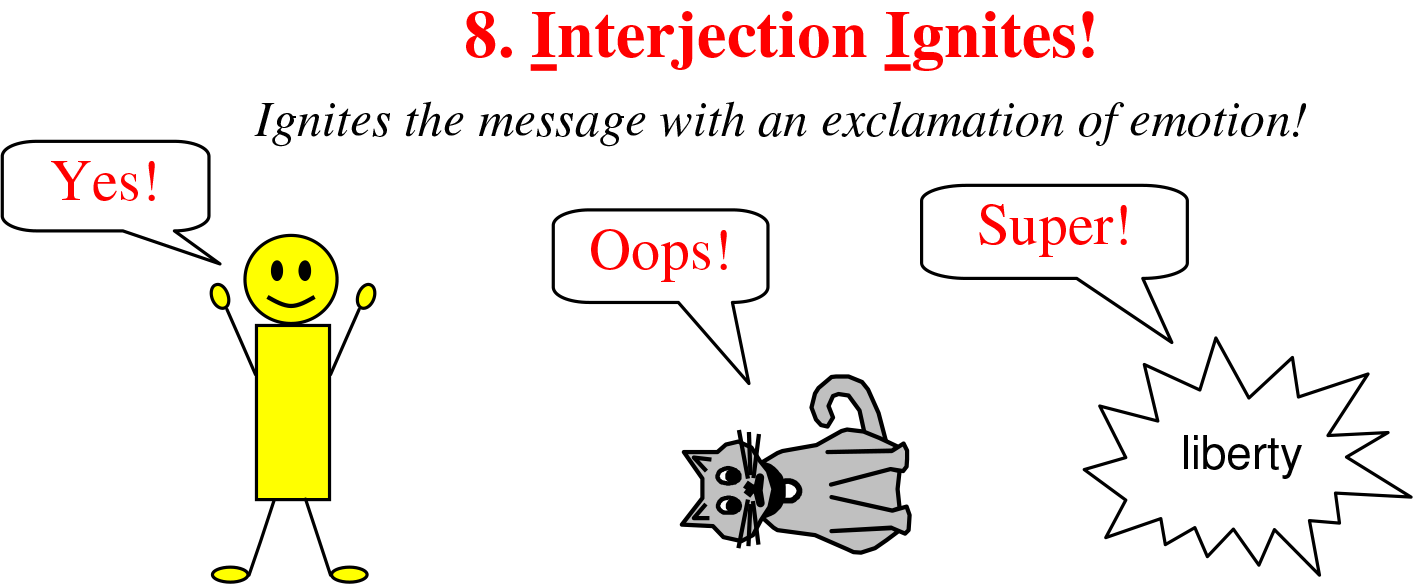
- Interjections are words used to express strong feeling or sudden emotion. They are included in a sentence - usually at the start - to express a sentiment such as surprise, disgust, joy, excitement or enthusiasm.An interjection is not grammatically related to any other part of the sentence
Interjections can stand alone or be part of a sentence. Expletives are interjectory words or expressions. There is no one here! Darn it!
- Yes! It’s me.
- Oh, is it?
- Hey! Get off that floor!
- Oh, that is a surprise.
- Good! Now we can move on.
Part of Speech Video Classes.

0 Comments